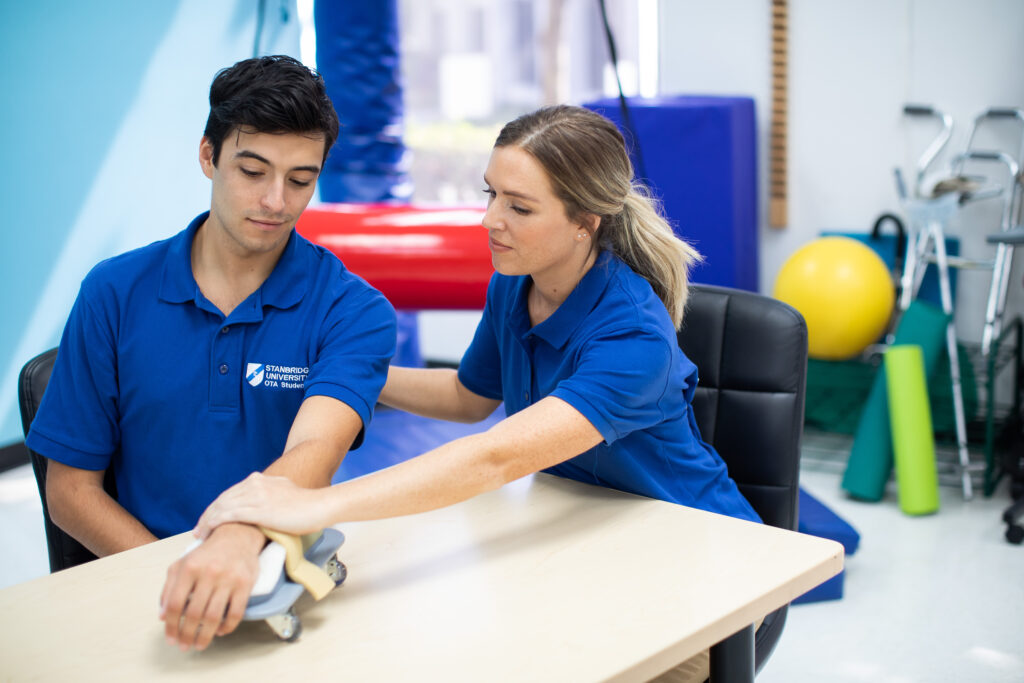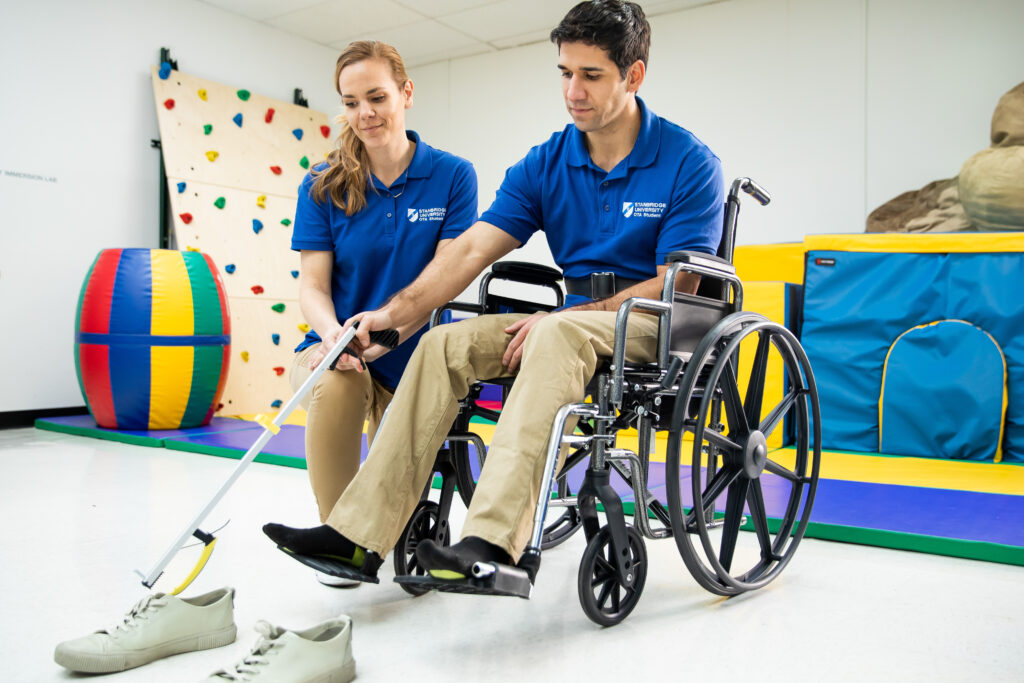Career Opportunities for Occupational Therapy Assistants: Diverse Settings to Make a Difference
Summary: Where Occupational Therapy Assistants Work
Occupational therapy assistants (OTAs) play a vital role in helping people regain independence after illness or injury. They work in hospitals, schools, nursing facilities, and community programs, anywhere patients need support in daily living.¹ According to the American Occupational Therapy Association (AOTA), OTAs also support patients in mental and behavioral health settings, helping them rebuild routines and develop healthy coping strategies that promote emotional well-being.² Through the Stanbridge University OTA program, students gain the hands-on training and field experience needed to navigate this career.
Where do occupational therapy assistants work? There’s no single answer. They may work wherever people need help recovering, adapting, or achieving greater independence, making it a career defined by both variety and purpose.¹
Occupational therapy assistants collaborate with licensed occupational therapists (OTs) to guide patients through therapeutic activities. Whether it’s teaching someone how to safely cook after a stroke or helping a child develop fine motor skills, OTAs make a lasting impact. Their skills are applicable in healthcare and community settings.¹
Hospitals and Rehabilitation Centers: The Heart of OTA Practice
Most OTAs begin their careers in hospitals or rehabilitation centers, settings where patients are recovering from surgeries, strokes, or injuries. In these environments, OTAs assist with exercises that improve strength and coordination, help patients practice mobility skills, and monitor progress during recovery.¹
Working alongside physicians, nurses, and occupational therapists, OTAs play a vital role in restoring function and confidence. It’s a collaborative environment that offers daily opportunities to see patients make progress toward independence.¹
Long-Term Care and Skilled Nursing Facilities: Supporting Everyday Living
For individuals managing chronic illness or aging-related conditions, OTAs in long-term care and skilled nursing facilities provide essential support. They help residents maintain independence through activities like dressing, grooming, and mobility exercises.¹
This setting allows OTAs to build lasting relationships with patients by offering both physical and emotional encouragement.
Schools and Pediatric Settings: Empowering Young Learners
In educational environments, occupational therapy assistants work closely with children who have developmental delays, sensory processing challenges, or physical disabilities. They collaborate with teachers, parents, and other specialists to design activities that improve focus, coordination, and classroom participation.¹
From practicing handwriting to building social interaction skills, OTAs in schools help children reach milestones that strengthen both their confidence and academic success.¹
Home Health and Community-Based Care: Bringing Therapy to Life
Some patients benefit most from therapy in their own homes. OTAs in home health care adapt activities and exercises to fit the patient’s environment, helping them regain independence where it matters most: their daily life.¹
Community-based OTAs may also work with nonprofit organizations or wellness programs that support individuals with disabilities or chronic conditions.¹
Mental Health and Wellness Programs: Supporting the Whole Person
Occupational therapy assistants also work in behavioral and mental health settings, supporting patients as they rebuild routines, social skills, and self-esteem. Through healthy routines and activities, OTAs help individuals develop coping strategies that promote emotional balance and daily functioning.²
As awareness of holistic health grows, this area of practice is creating new opportunities for OTAs to address both the mental and physical aspects of recovery.
Alternative Career Paths for Occupational Therapy Assistants
So, what other jobs can occupational therapy assistants do? The skills OTAs develop, such as communication, empathy, problem-solving, and adaptability, translate well into many related fields. Some transition into roles in rehabilitation coordination, patient education, or healthcare management.¹
Many also choose to advance their education. For example, graduates of Stanbridge University’s Occupational Therapy Assistant program may later pursue a Bachelor’s Degree and then a Master of Science in Occupational Therapy (MSOT) to become licensed occupational therapists (OTs).
Preparing for a Rewarding OTA Career at Stanbridge University
The Associate of Science in Occupational Therapy Assistant program at Stanbridge University is accredited by the Accreditation Council for Occupational Therapy Education (ACOTE®) of the American Occupational Therapy Association (AOTA), ensuring that graduates are prepared to meet the profession’s highest standards.³ The program is offered at the Orange County (Irvine) and Los Angeles (Alhambra) campuses.
Stanbridge University’s OTA graduates continue to achieve strong outcomes on the National Board for Certification in Occupational Therapy (NBCOT®) exam. Across the Orange County (Irvine) and Los Angeles (Alhambra) campuses, graduates achieved NBCOT-COTA pass rates of 83% in 2024, reflecting the university’s ongoing commitment to academic excellence.⁴
Stanbridge University Recognition
Stanbridge University offers healthcare degree programs across its Southern California campuses in Irvine, Alhambra, Riverside, and San Marcos. The university has been recognized for both academic excellence and workplace culture, including recognition in the 2025 Carnegie Classifications as an Opportunity College⁵ and in Research.com’s 2024 Best Healthcare Degree Programs in America.⁶
Its Orange County campus earned the 2024–2025 ACCSC School of Excellence Award,⁷ and in 2025, Georgetown University’s Center on Education and the Workforce ranked Stanbridge among the top 5% of U.S. colleges for 10-year return on investment, based on earnings and tuition data from qualifying programs.⁸ Stanbridge is accredited by Investors in People (London)⁹ and certified as a Great Place to Work.¹⁰
The Takeaway: Where Do Occupational Therapy Assistants Work?
So, where do occupational therapy assistants work? Their opportunities extend far beyond hospitals or rehabilitation centers. OTAs play a meaningful role in schools, mental health programs, home health, and community outreach; anywhere people need help restoring independence and improving quality of life.¹
Are you ready to launch a career that helps you make a difference? Learn more about Stanbridge University’s OTA program, offered at the Orange County (Irvine) and Los Angeles (Alhambra) campuses. You can also schedule a meeting with the admissions team to start your journey toward a fulfilling career in occupational therapy.
Frequently Asked Questions
They work wherever people need help recovering, adapting, or achieving greater independence, making it a career defined by both variety and purpose.¹
OTAs work with people of all ages, from children with developmental delays to adults recovering from injury or stroke and seniors managing chronic conditions.¹
The Associate of Science in Occupational Therapy Assistant program at Stanbridge University takes approximately 22-23 months to complete, including fieldwork experiences that help students apply their skills in professional settings.¹¹
Occupational therapists (OTs) evaluate and plan treatment programs, while occupational therapy assistants (OTAs) carry out those plans under OT supervision, providing direct care and support to patients.¹
Footnotes
¹ Source: Bureau of Labor Statistics, U.S. Department of Labor, Occupational Outlook Handbook, Occupational Therapy Assistants and Aides, https://www.bls.gov/ooh/healthcare/occupational-therapy-assistants-and-aides.htm. As viewed on November 3, 2025.
² Source: American Occupational Therapy Association (AOTA), Occupational Therapy in Mental and Behavioral Health: Overview of OT Roles, https://www.aota.org/-/media/corporate/files/advocacy/federal/overview-of-ot-in-mental-health.pdf. As viewed on November 3, 2025.
³ Source: Accreditation Council for Occupational Therapy Education (ACOTE®) of the American Occupational Therapy Association (AOTA), Accreditation Status, https://acoteonline.org/schools/?_schools=ota-associate&_paged=4. As viewed on November 3, 2025.
⁴ Source: NBCOT-COTA Pass Rates, 2022–2024, Orange County and Los Angeles campuses; National Board for Certification in Occupational Therapy, https://www.nbcot.org/Educators-Folder/SchoolPerformance. As viewed on April 14, 2025.
⁵ Source: https://carnegieclassifications.acenet.edu/institution/stanbridge-university/. As viewed on May 21, 2025.
⁶ Source: Research.com, 2024 Best Healthcare Degree Programs Ranking in America, https://research.com/rankings/healthcare/best-healthcare-usa/?award=f3d66c8ef200b579. Email communication from Chief Data Scientist and Ranking Editor, Imed Bouchrika, Ph.D., to Director of Marketing, Victoria Sauer. As viewed on December 12, 2024.
⁷ Source: Stanbridge University, Orange County campus, Accrediting Commission of Career Schools and Colleges (ACCSC) School of Excellence 2025 Award. Email communication from Michelle Ragland, Member Services and Events Manager, ACCSC, to Director of Marketing, Victoria Sauer. As viewed on July 17, 2025.
⁸ Source: https://cew.georgetown.edu/cew-reports/roi2025/. As viewed March 19, 2025.
⁹ Source: Investors in People. https://www.investorsinpeople.com/. As viewed on June 13, 2025.
¹⁰ Source: Great Place to Work. https://www.greatplacetowork.com/certified-company/7021962. As viewed on September 17, 2025.
¹¹ Program duration subject to change. Completion times vary depending upon the start and end dates of a cohort and any individual circumstances that may impact progression.


